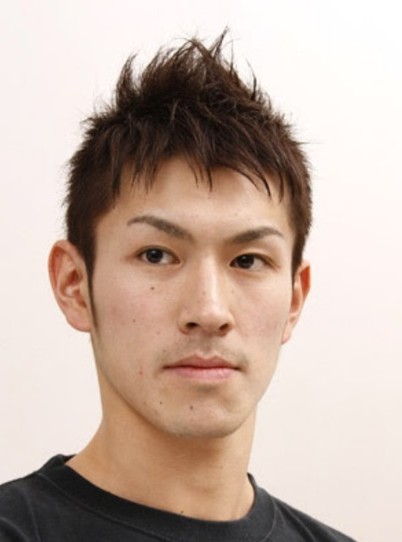Nature Mens Hairstyles Biography
Source:-Google.com.pk
As the trend of men’s grooming continues to grow, it is important to make sure you know what styles best shape of your face. Japanese hairstyles for men may be surprising to learn how many different faces, but if you take the time to look – if only for five minutes – this is very noticeable. Finding a suitable hairstyle heart shaped face, however, are fairly straight forward.The reason for Japanese hairstyles for men is because of the symmetry of nature and of wrinkles is. In fact, the only rule when looking for hairstyles for a heart shaped face man to make sure that there is not too much weight, too much body sides of the head: This is where your head is at its widest, and could easily be filled and attractive.Having a consultation with a good hair stylist can help you decide which style to decide if you are not sure of making decisions for themselves. But there are some tips you can rest assured that you have the confidence to walk out of the salon look.Longer hair, well-styled, can be an excellent appearance. But this also depends on your lifestyle and appearance. If you have powerful features, it can not be a great success.If you are unsure, and lacking a bit of confidence to pull off the signature Japanese hairstyles for men , your best bet is to go with something cut quite short and structured. A little more confidence, but the “Faux-Hawk” cut be an option.Dreadlocks, also called locks, a ras, dreads, or Jata (Hindi), are matted coils of hair. Dreadlocks are usually intentionally formed; because of the variety of different hair textures, various methods are used to encourage the formation of locks such as backcombing. Additionally, leaving long hair to its own devices by not brushing or cutting the hair will encourage it to tangle together as it grows, leading to twisted, matted ropes of hair known as dreadlocks. The latter method is typically referred to as the neglect, natural, organic, or freeform method. A common misconception is that those who have dreadlocks do not wash their hair, but this is usually not the case. Many dreadlock care regimens require the wearer to wash their hair up to twice a week.Dreadlocks are associated most closely with the Rastafari movement, but people from many ethnic groups have worn dreadlocks, including many ancient Hamitic people of North Africa and East Africa (notably the Oromo of Ethiopia, and the Maasai of northern Kenya); Semitic people of West Asia; Indo-European people of Europe and South Asia (notably the ancient Spartan warriors of Greece, and the Sadhus of India and Nepal); Turkic people of Anatolia and Central Asia; the Sufi Rafaees; and the Sufi malangs and fakirs of Pakistan.Spartan officer depicted with locked hair.The first known examples of dreadlocks date back to North Africa and the Horn of Africa. In ancient Egypt examples of Egyptians wearing locked hairstyles and wigs have appeared on bas-reliefs, statuary and other artifacts.Mummified remains of ancient Egyptians with locks, as well as locked wigs, have also been recovered from archaeological sites.Maasai men found in the regions of northen Kenya claim that they have been wearing dreadlocks for as long as they have survived. According to their oral history, the Maasai originated from the lower Nile valley north of Lake Turkana (Northwest Kenya) and began migrating south around the 15th century, arriving in a long trunk of land stretching from what is now northern Kenya between the 17th and late 18th century.. Even today, Maasai men can be found donning their dreadlocks, with a tint of red color from the soil.The Hindu deity Shiva and his followers were described in the scriptures as wearing "Jataa", meaning "twisted locks of hair". The Greeks and several ascetic groups within various major religions have at times worn their hair in locks, including the monks of the Ethiopian Orthodox Tewahedo Church, the Nazirites of Judaism, Qalandari Sufi's, the Sadhus of Hinduism, and the Dervishes of Islam, among others. The very earliest Christians also may have worn this hairstyle. Particularly noteworthy are descriptions of James the Just, first Bishop of Jerusalem, who wore them to his ankles.Pre-Columbian Aztec priests were described in Aztec codices (including the Durán Codex, the Codex Tudela and the Codex Mendoza) as wearing their hair untouched, allowing it to grow long and matted.In Senegal, the Baye Fall, followers of the Mouride movement, a sect of Islam founded in 1887 by Shaykh Aamadu Bàmba Mbàkke, are famous for growing locks and wearing multi-colored gowns.Cheikh Ibra Fall, founder of the Baye Fall school of the Mouride Brotherhood, popularized the style by adding a mystic touch to it. It's important to note that warriors among the Fulani, Wolof and Serer in Mauritania, and Mandinka in Mali and Niger were also known to have dreadlocks when old and cornrows Pictish carved stone depicting Samson with locked hair. In the Book of Judges 16:19 of the Old Testament, Samson loses his strength when his seven dreadlocks are cut from his head.All the days of the vow of his separation there shall no razor come upon his head: until the days be fulfilled, in the which he separateth himself unto the LORD, he shall be holy, and shall let the locks of the hair of his head grow.A dreadlocked Samson fights the dreadlocked lion in this drawing from a 15th-century Icelandic manuscript.There are many reasons among various cultures for wearing locks. Locks can be an expression of deep religious or spiritual convictions, ethnic pride, a political statement, or be simply a fashion preference. In response to the derogatory history of the term dreadlocks, an alternative name for the style is locks (sometimes spelled "locs").Africa and the Western World; Caribbean, North and South America[edit]Africans and people of African descent are known to wear this hairstyle. Members of various African ethnic groups wear locks and the styles and significance may change from one group to another.Maasai warriors are famous for their long, thin, red locks. Many people dye their hair red with root extracts or red ochre. In various cultures what are known as shamans, spiritual men or women who serve and speak to spirits or deities, often wear locks. In Benin the Yoruba priests of Olokun, the Orisha of the deep ocean, wear locks.
Nature Mens Hairstyles Free Pictures Pics Images Photos 2013
 Nature Mens Hairstyles Free Pictures Pics Images Photos 2013
Nature Mens Hairstyles Free Pictures Pics Images Photos 2013
 Nature Mens Hairstyles Free Pictures Pics Images Photos 2013
Nature Mens Hairstyles Free Pictures Pics Images Photos 2013
 Nature Mens Hairstyles Free Pictures Pics Images Photos 2013
Nature Mens Hairstyles Free Pictures Pics Images Photos 2013
 Nature Mens Hairstyles Free Pictures Pics Images Photos 2013
Nature Mens Hairstyles Free Pictures Pics Images Photos 2013
 Nature Mens Hairstyles Free Pictures Pics Images Photos 2013
Nature Mens Hairstyles Free Pictures Pics Images Photos 2013
 Nature Mens Hairstyles Free Pictures Pics Images Photos 2013
Nature Mens Hairstyles Free Pictures Pics Images Photos 2013
 Nature Mens Hairstyles Free Pictures Pics Images Photos 2013
Nature Mens Hairstyles Free Pictures Pics Images Photos 2013
 Nature Mens Hairstyles Free Pictures Pics Images Photos 2013
Nature Mens Hairstyles Free Pictures Pics Images Photos 2013
 Nature Mens Hairstyles Free Pictures Pics Images Photos 2013
Nature Mens Hairstyles Free Pictures Pics Images Photos 2013
 Nature Mens Hairstyles Free Pictures Pics Images Photos 2013
Nature Mens Hairstyles Free Pictures Pics Images Photos 2013










No comments:
Post a Comment